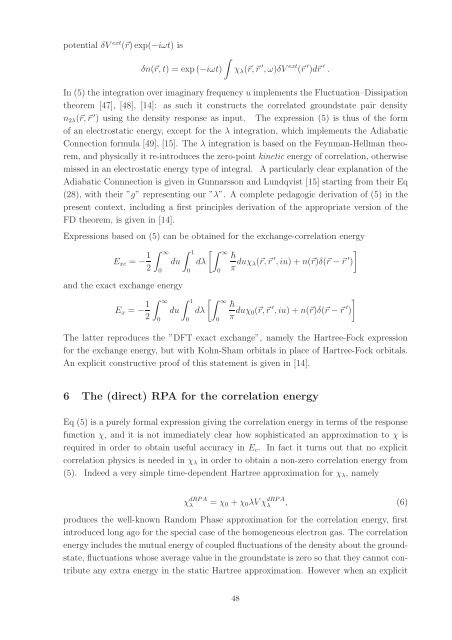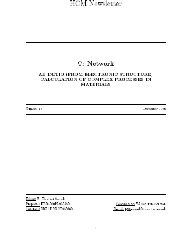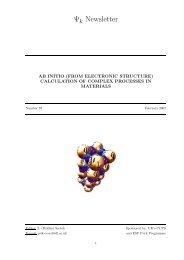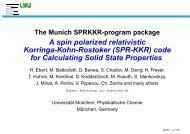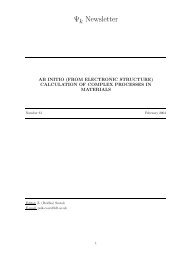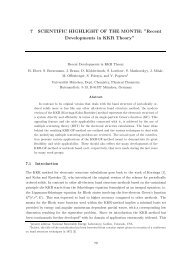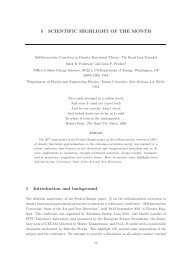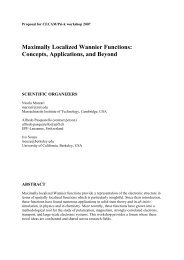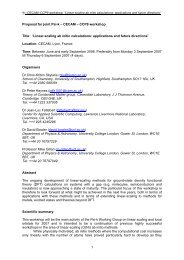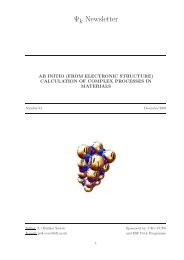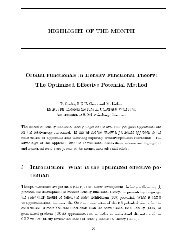Newsletter 107 - October 2011 - (pdf - 0.6 MB) - Psi-k
Newsletter 107 - October 2011 - (pdf - 0.6 MB) - Psi-k
Newsletter 107 - October 2011 - (pdf - 0.6 MB) - Psi-k
You also want an ePaper? Increase the reach of your titles
YUMPU automatically turns print PDFs into web optimized ePapers that Google loves.
potential δV ext (⃗r) exp(−iωt) is<br />
∫<br />
δn(⃗r, t) = exp (−iωt)<br />
χ λ (⃗r,⃗r ′ , ω)δV ext (⃗r ′ )d⃗r ′ .<br />
In (5) the integration over imaginary frequency u implements the Fluctuation–Dissipation<br />
theorem [47], [48], [14]: as such it constructs the correlated groundstate pair density<br />
n 2λ (⃗r,⃗r ′ ) using the density response as input. The expression (5) is thus of the form<br />
of an electrostatic energy, except for the λ integration, which implements the Adiabatic<br />
Connection formula [49], [15]. The λ integration is based on the Feynman-Hellman theorem,<br />
and physically it re-introduces the zero-point kinetic energy of correlation, otherwise<br />
missed in an electrostatic energy type of integral. A particularly clear explanation of the<br />
Adiabatic Connnection is given in Gunnarsson and Lundqvist [15] starting from their Eq<br />
(28), with their ”g” representing our ”λ”. A complete pedagogic derivation of (5) in the<br />
present context, including a first principles derivation of the appropriate version of the<br />
FD theorem, is given in [14].<br />
Expressions based on (5) can be obtained for the exchange-correlation energy<br />
E xc = − 1 ∫ ∞ ∫ 1<br />
[∫ ∞<br />
]<br />
<br />
du dλ<br />
2<br />
π duχ λ(⃗r,⃗r ′ , iu) + n(⃗r)δ(⃗r − ⃗r ′ )<br />
and the exact exchange energy<br />
E x = − 1 2<br />
0<br />
∫ ∞<br />
0<br />
du<br />
0<br />
∫ 1<br />
0<br />
0<br />
[∫ ∞<br />
]<br />
<br />
dλ<br />
0 π duχ 0(⃗r,⃗r ′ , iu) + n(⃗r)δ(⃗r − ⃗r ′ )<br />
The latter reproduces the ”DFT exact exchange”, namely the Hartree-Fock expression<br />
for the exchange energy, but with Kohn-Sham orbitals in place of Hartree-Fock orbitals.<br />
An explicit constructive proof of this statement is given in [14].<br />
6 The (direct) RPA for the correlation energy<br />
Eq (5) is a purely formal expression giving the correlation energy in terms of the response<br />
function χ, and it is not immediately clear how sophisticated an approximation to χ is<br />
required in order to obtain useful accuracy in E c . In fact it turns out that no explicit<br />
correlation physics is needed in χ λ in order to obtain a non-zero correlation energy from<br />
(5). Indeed a very simple time-dependent Hartree approximation for χ λ , namely<br />
χ dRPA<br />
λ<br />
= χ 0 + χ 0 λV χ dRPA<br />
λ , (6)<br />
produces the well-known Random Phase approximation for the correlation energy, first<br />
introduced long ago for the special case of the homogeneous electron gas. The correlation<br />
energy includes the mutual energy of coupled fluctuations of the density about the groundstate,<br />
fluctuations whose average value in the groundstate is zero so that they cannot contribute<br />
any extra energy in the static Hartree approximation. However when an explicit<br />
48


